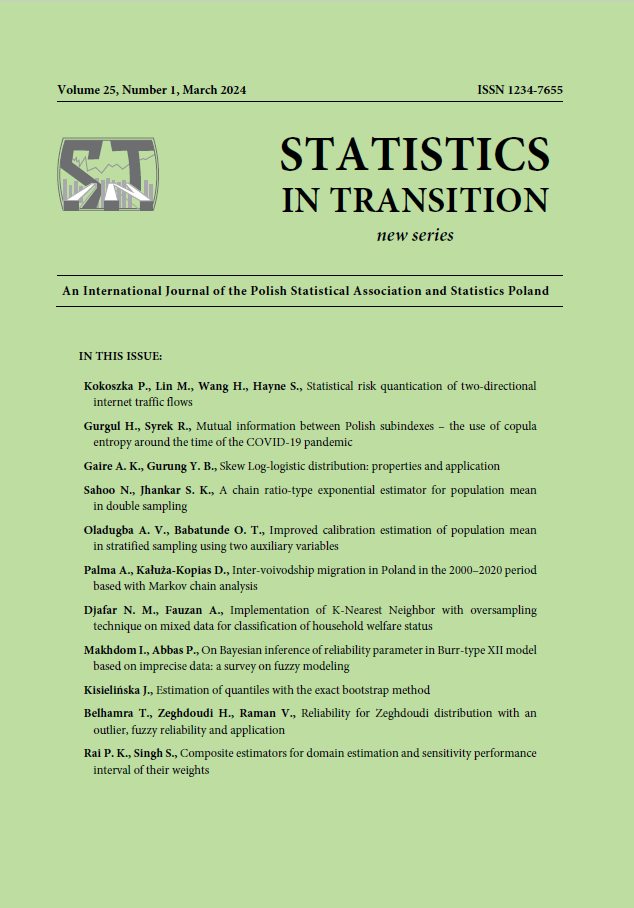ARTICLE
ABSTRACT
A problem with the estimation of quantiles occurs when the sample comes from an unknown distribution. The estimation uses the bootstrap method in the version that the literature refers to as exact. Three bootstrap estimators were used: two of them based on one order statistic, and the third on a linear combination of two order statistics (for an integer). The distribution of the exact bootstrap estimator based on a single order statistic is known. It has been shown that there is no general form of the distribution of the exact bootstrap estimator based on two order statistics. However, it is possible to calculate such a distribution – the article presents the algorithm that performs such a task. The bootstrap confidence intervals were constructed using the exact percentile method. It has been shown that if the estimator is based on a single order statistic, it is known in advance which elements of the primary sample are the limits of the confidence intervals, so there is no need to resample. The intervals determined by the exact percentile method were compared with those constructed using other methods. It has been shown that the information on the direction of the asymmetry of the distribution that the sample comes from is worth considering when selecting the rank of the order statistic used as an estimator. Attention is paid to the influence of the quality of the pseudorandom number generators on the results of the Monte Carlo simulation.
KEYWORDS
quantile estimation, confidence intervals for quantile, exact bootstrap method, exact percentile method, Monte Carlo method
REFERENCES
Altman, E. I., (1968). Financial Ratios, Discriminant Analysis and the Prediction of the Corporate Bankruptcy. The Journal of Finance, vol. 23, pp. 589–609.
Chen, J. H., Williams, M., (1999). The determinants of business failures in the US lowtechnology and high-technology industries. Applied Economics, vol. 31, pp. 1551– 1563.
European Commission, (2003). BEST project on restructuring, bankruptcy and a fresh start: Final report of the expert, Enterprise Directorate-General.
Bahadur, R. R., (1966). A note on quantiles in large samples. The Annals of Mathematical Statistics, vol. 37(3), pp. 577–580.
Bickel, P. J., Freedman, D. A., (1981). Some asymptotic theory for the bootstrap. Ann. Statist., vol. 9(9), pp. 1196–1217.
David, H. A., Nagaraja, H. N., (2003). Order Statistics, Wiley & Sons, Inc.
De Angelis, D., Hall, P., Young, G. A., (1993). A note on coverage error of bootstrap confidence intervals for quantiles. Math. Proc. Camb. Phil. Soc., vol. 114(3), pp. 517–531.
Efron, B., (1979). Bootstrap Methods: Another look at the jackknife. The Annals of Statistics, vol. 7, no. 1, 1–26.
Efron, B., (1987). Better bootstrap confidence intervals (with discussion). J. Amer. Statist. Assoc., vol. 82(39), pp. 171–185.
Efron, B., Tibshirani, R. J., (1993). An introduction to the Bootstrap, New York: Chapman & Hall.
Evans, D. L., Leemis, L. M., Drew, J. H., (2006). The distribution of order statistics for discrete random variables with applications of bootstrapping. Journal on Computing, vol. 18(1), pp. 19–30.
Falk, M., Kaufmann, E., (1991). Coverage probabilities of bootstrap-confidence intervals for quantiles. Ann. Statist., vol. 19(1), pp. 485–495.
Falk, M., Reiss, R. D., (1989). Weak convergence of smoothed and nonsmoothed bootstrap quantile estimates. Ann. Probab., vol. 17(1), pp. 362–371.
Fisher, N. I., Hall, P., (1991). Bootstrap algorithms for small samples. Journal of Statistical Planning and Inference, vol. 27, pp. 157–169.
Hettmansperger, T. P., Sheather, S. J., (1986). Confidence intervals based on interpolated order statistics. Statist. Probab. Lett., vol. 4(2), pp. 75–79.
Hutson, A. D., (2002). A semi-parametric quantile function estimator for use in bootstrap estimation procedures. Stat. Comput., vol. 2(4), pp. 331–338.
Hutson, A. D., Ernst, M. D., (2000). The exact bootstrap mean and variance of an L-estimator. Journal of the Royal Statistical Society: Series B, vol. 62(1), pp. 89–94.
Hyndman, R. J., Fan, Y., (1996). Sample quantiles in statistical packages. The American Statistician, vol. 50(4), pp. 361–365.
Koehler, E., Brown, E., Haneuse, J.-P.A., (2009). On the assessment of Monte Carlo error in simulation-based statistical analyses. Amer. Statist., vol. 63(2), pp. 155–162.
Kisielińska, J., (2013). The exact bootstrap method shown on the example of the mean and variance estimation. Computational Statistics, vol. 28(3), pp. 1061–1077.
Maritz, J. S., Jarrett, R. G., (1978). A note on estimating the variance of the sample median. Journal of the American Statistical Association, vol. 73(361), pp. 194–196.
Nagaraja, C. H, Nagaraja, H. N., (2020). Distribution-free approximate methods for constructing confidence intervals for quantiles. International Statistical Review, vol. 88(1), pp. 75–100.
Nyblom, J., (1992). Note on interpolated order statistics. Statist. Probab. Lett., vol. 14(2), pp. 129–131.
Parrish, R. S., (1990). Comparison of quantile estimators in normal sampling. Biometrics, vol. 46, pp. 247–257.
Pekasiewicz, D., (2015). Order statistics in estimation procedures and their applications in economic research, University of Lodz, Lodz.
Serfling, R. J., (1980). Approximation theorems of mathematical statistics, John Wiley & Sons, New York, Chichester, Brisbane, Toronto, Singapore.
Sulewski, P., (2019). Comparison of normal random number generators, Wiadomości Statystyczne. The Polish Statistician, vol. 64, pp. 5–31.
Singh, K., (1981). On the asymptotic accuracy of Efron’s bootstrap. Ann. Statist., vol. 9(6), pp. 1187–1195.
Wilcox, R. R., (2001). Fundamentals of modern statistical methods, Springer, New York.
